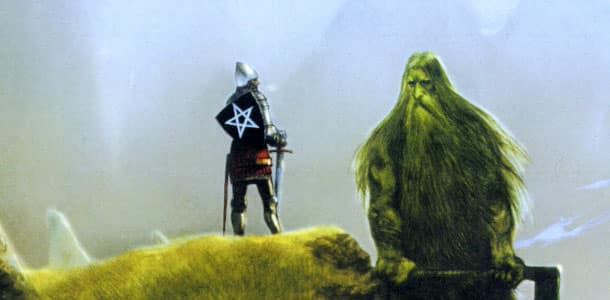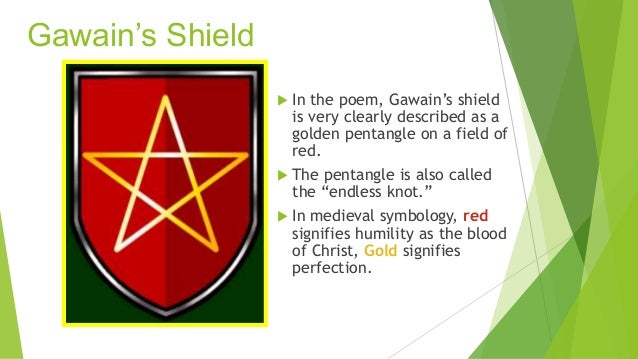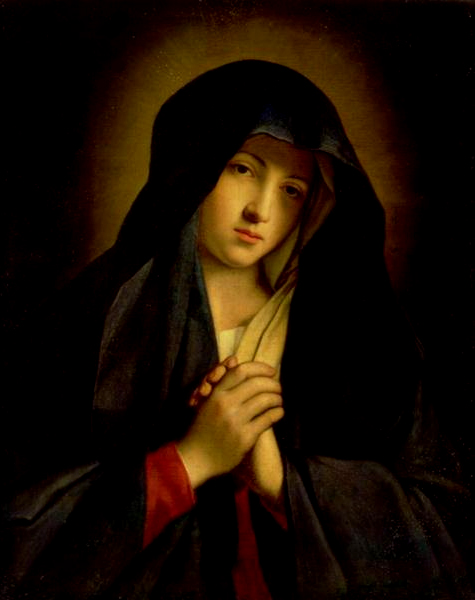This is the second and final post on Sir Gawain and the Green Knight. You can read the first here.
There are two motifs in Sir Gawain that I find captivating. One is the shaming motif. At various key points in the narrative, shame is used to challenge Sir Gawain and prod him to action. If the central theme of the story is knightly courage, shame at failing to live up to that courage is the motivation that keeps Gawain courageous. The other is feminine motif that contrasts against the more masculine acts of manhood and courage.
Let me explore the shaming motif first. When the Green Knight shows up at King Arthur’s feast, he challenges with a particular bravado.
But it’s Yuletide—a time
of youthfulness, yes?
So at Christmas in this
court I lay down a challenge:
if a person here present,
within these premises,
is big or bold or red
blooded enough
to strike me one stroke
and be struck in return,
I shall give him as a
gift this gigantic cleaver
and the axe shall be his to handle how he likes. (283-9)
I’m
quoting from the Simon Armitage translation, which by the way is
excellent. The Green knight could have
just said is there anyone willing to play this game with me? That would have been more well-mannered, or even
courteous, as knights were supposed to behave.
But he comes out like a low brow, street fighter. “Are you red-blooded enough? Are you bold?
Do you have what it takes?” He is
framing the challenge to their masculinity.
So when there is some hesitation, he continues by increasing the bravado.
“So here is the House of
Arthur,” he scoffed,
“whose virtues
reverberate across vast realms.
Where’s the fortitude and
fearlessness you’re so famous for?
And the breathtaking
bravery and the big-mouth bragging?
The towering reputation
of the Round Table,
skittled and scuppered by
a stranger—what a scandal!
You flap and you flinch
and I’ve not raised a finger!”
Then he laughed so loud
that their leader saw red.
Blood flowed to his
fine-featured face and he raged inside.
His men were also hurt—
Those words had pricked their pride. (309-20)
The Green knight “scoffs” them into embarrassment. He laughs at the great Knights of the Round Table, whose reputation is apparently just talk. That shame leads Arthur to rise up and then Gawain to take the challenge for his uncle. So Gawain agrees to the deal and lops the Green Knight’s head off, only to be shocked that the Green Knight is still alive and speaks through the mouth of the decapitated head. And before the Green knight goes away, carrying his head, he pins Gawain down to maintain the deal.
“Sir Gawain, be wise
enough to keep your word
and faithfully follow me
until I’m found
as you vowed in this hall
within hearing of these horsemen.
You’re charged with getting
to the Green Chapel,
to reap what you’ve sown.
You’ll rightfully receive
the justice you are due
just as January dawns.
Men know my name as the
Green Chapel knight
and even a fool couldn’t
fail to find me.
So come, or be called a coward forever.” (448-56)
Be
there or forever be labeled a coward. It
would tarnish a knight’s reputation into eternity if he would be labeled such a
coward. That threat of everlasting shame
is the motivating factor that propels Gawain from here on out. He must meet the Green knight on New Year’s
Day. He cannot compromise on it.
What
is interesting is that Gawain makes two promises in the story. One that he will return to the Green knight
to receive his blow on the neck, and that he will exchange with Bertilak
everything Gawain wins while Bertilak is hunting. The first promise Gawain keeps, and that is
the one that is linked to shame. The
second promise he compromises on. He
give Bertilak the kisses he receives but he doesn’t give him the green girdle,
which saves Gawain’s life. So when
Gawain finally finds the chapel of the Green knight, a forest “wildman” tries
to persuade Gawain to flee, but Gawain again is pricked by shame of such an
action.
I’m sure such a secret
would be silent in your keep,
But as faithful as you
are, if I failed to find him
and lost my mettle in the
manner you mentioned,
I’d be christened a coward, and could not be excused. (2128-31)
So
when he meets the Green knight and is about to take the blow, Gawain flinches,
and the Green knight resorts again to his shaming ethic.
“Call yourself good Sir
Gawain?” he goaded,
“who faced down every foe
in the field of battle
but now flinches with
fear at the foretaste of harm.
Never have I known such a
namby-pamby knight.
Did I budge or even blink
when you aimed the axe,
or carp or quibble in
King Arthur’s castle,
or flap when my head went
flying to my feet?
But entirely untouched,
you are terror struck.
I’ll be found the better
fellow, since you were so feeble
and frail.” (2270-9)
He
calls Gawain “such a namby-pamby knight.”
That’s funny. The Armitage
translation really plays the Green knight as a brawler. Shamed Gawain steadies his head to receive the
blow and the Green knight misses. Then
on the third attempt, Gawain is only nicked on the neck. And with that Gawain learns that the Green
knight is Bertilak, and that Gawain is shamed for withholding the green
girdle. Though Gawain had the manly
courage to take the Gren knight’s blow, in the end he is shamed for not being
honest.
“My downfall and undoing;
let the devil take it.
Dread of the death blow
and cowardly doubts
meant I gave in to greed,
and in doing so forgot
the fidelity and kindness
which every knight knows.
As I feared, I am found
to be flawed and false,
through treachery and
untruth I have totally failed,” said
Gawain.
“Such
terrible mistakes,
And
I shall bear the blame.
But
tell me what it takes
to clear my clouded name. (2378-88)
So in the end, his reputation is still on his mind. While the shame in the end has to do with Gawain’s honesty, it too is linked to courage. He lied because he didn’t have the courage to take a death blow. While I think the shame here is mitigated (he had no idea if the girdle would actually protect him) the scar on his neck will remind him and every one that he did chicken out somewhat.
###
The second motif that fascinated me was what I’ll call the feminine motif. Prominent of this motif are the seduction scenes by the unnamed Bertilak’s wife. But I count three other women in narrative. At Bertilak’s castle alongside Bertilak’s wife is an old crone who we later find out is Morgan le Fay. Morgan le Fay is a sorceress, sometimes said to be the sister of King Arthur, and, depending in which tradition of the Arthurian legends you follow, can span from either a good woman—she has been a healer, especially to Arthur—to an evil woman, an enchantress of knights. Though Morgan is only seen very briefly in the Gawain and the Green Knight narrative, we learn she is at the crux of all the events. It was at her mischievous will and trickery to conceive and conduct the entire sordid events, the cutting off of the Green knight’s head, the challenge to Gawain, and the possible decapitation of a great Knight of the Round Table. Why would she do this? We are told Morgan wanted to frighten to death her object of loathing, Queen Guenevere.
Which brings us to the third woman, King Arthur’s wife, Queen Guenevere. What are we to make of Queen Guenevere? If she can be mortified to the point of death by a decapitation, then she stands as a sort of innocent, a young bride of which the sophisticated old crone intends to despoil. We see Sir Gawain sitting by the queen the whole time in that opening scene when the Green knight barges into King Arthur’s court. Is Gawain the protector of innocence? Medieval stories tended to work in allegory, and so I would conclude Gawain is the chivalrous protector of the purity of the young Queen. So then these three women range from a young innocent woman, a middle aged seductress, and an aged evil crone. The old crone is the emitter of evil, sending out devilry out into the world, using the middle aged woman to make Gawain morally succumb to sin, and thereby destroy the purity of the innocent.
But who is the fourth woman? The Blessed Mother, the Queen of heaven herself. Throughout the story we hear Gawain’s appeal to the Blessed Virgin. We are told whenever Gawain was in a terrible fight, what pulled him through was the Blessed Mother.
And fourthly, if that
soldier [Gawian] struggled in skirmish
one thought pulled him
through above all other things:
the fortitude he found in
the five joys
which Mary had conceived
in her son, our Savior.
For precisely that reason
the princely rider
had the shape of her
image inside his shield,
so by catching her eye his courage would not crack. (644-50)
And when he is lost forest, he appeals to God and the Blessed Mother.
So in peril and pain Sir
Gawain made progress,
crisscrossing the
countryside until Christmas
Eve. Then
at that time of tiding,
he prayed to highest
heaven.
Let Mother Mary guide him
towards some house or haven. (733-9)
He
continues in prayer:
He prayed with heavy
heart. “Father, hear me,
and Lady Mary, our mother
most mild,
let me happen on some
house where mass might be heard,
and matins in the
morning; meekly I ask,
and here I utter my
pater, ave
and creed.”
He rides the path and
prays,
dismayed by his misdeeds,
and signs Christ’s cross
and says,
“Be near me in my need.” (753-62)
This appeal to Mary is quite frequent, and in essence the Blessed Virgin becomes the fourth woman in the story.
So we have Gawain being seduced by evil forces but he relies on the Blessed Mother for strength to resist the seduction. It’s interesting that if Gawain falls for the seduction, then he is in an adulterous affair in the same way Lancelot and Guenevere will be in an adulterous affair later on Arthur’s reign. As it turns out, it is Gawain who uncovers that adulterous affair. I’m not sure if the author of this tale is aware of that, but certainly he had to be aware of Lancelot and Guenevere.
So the feminine motif comprises a full range of female virtue: the purity of the Holy Virgin, the innocence of young Guenevere, which in time will be innocence lost, the devolving into evil of the seductress and adulterous wife, and finally the malicious evil of an envious old crone.
And what are we to make of Gawain under the stress of temptation? While he does maintain his chastity, could one say he is entirely pure? Receiving kisses from a woman who is not your wife and in your bedroom seducing you is hardly purity. The increasing number of kisses suggest an increasing level of succumbing. If the week had gone on longer than three days, who knows?
One can see then the author of the tale uses the feminine to permeate evil into the world in order to test the knight’s virtue but he also uses the feminine as an antidote to that evil for him to uphold his virtue. Through the feminine we have both goodness and malevolence. Gawain is ultimately tainted with sin, but the level of sin is mitigated in the sense he succumbs to a venial sin rather than a mortal sin. Perhaps this analogy follows the dramatic conclusion. His head is not lopped off, which could be seen as a punishment for a mortal sin but his neck is nicked, which is akin to a venial sin.
###
I didn’t point this out earlier, but better late than never. There are a number of free translations on the internet. You can find J.R.R. Tolkien’s fine translation here.
There is a BBC discussion on the poem with Simon Armitage on the panel. It’s a fine discussion and definitely worth your time.
The BBC does these literary discussions so well. I have to say though I disagree with Armitage on one thing. He doesn’t believe that the poem is religious, and I disagree. I think it’s profoundly religious as I have pointed out with the Blessed Mother as contrast to the women in the poem. I still think his translation is the best that I sampled.
###
My Goodreads Review:
This is a whole hearted five star ranking. It’s a wonderful poetic classic of Middle English, full of knights, ladies, marvels, decapitations without death, bewitchments, and tests of courage. Sir Gawain of King Arthur’s Knights of the Round Table is challenged and in one year’s time will have to face the cutting off of his head. What saves Gawain is his faith in Christ and the Blessed Mother. Along the way he is tempted, prays, maintains his virtue, and comes away keeping his head.
The
poetry is exquisite. A lot does depend
on the verse translation into modern English, but the alliterative verse form
translates well into modern English. I
really enjoyed the Simon Armitage translation.
He simultaneously makes it sound contemporary while capturing the rhythm
of the Middle English. I also enjoyed
the audiobook version of Armitage’s translation read by Bill Wallis. The combination of reading and listening was
a real pleasure.






No comments:
Post a Comment